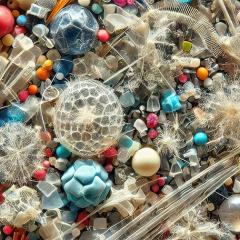Galápagos and the Plastic Problem
Plastic pollution (PP) is an ongoing, pervasive global problem that represents a risk to the Galápagos archipelago, despite it being one of the world’s most pristine and well-protected regions. By working closely with citizen scientists, we aimed to quantify and map the magnitude and biological effects of PP. With microplastic abundance ranging from 0.003 to 2.87 items/m2, our research indicated that all five sampled Galápagos bioregions are contaminated with PP along their coastlines. The distribution of this debris is not uniform, with microplastic significantly higher on the windward shores. Based on the identification information found on the examined items, Polyethylene terephthalate (PET) was the most predominant type of plastic originating from both consumer and fisheries-based products deriving primarily from Peru, China, and Ecuador. The top three manufacturers were AjeCroup, Coca-Cola, and Tingy Holding Corporation. Through citizen science, we documented PP exposure in 52 species (20 endemic) in Galápagos terrestrial and marine environments, with exposure occurring in two ways: entanglement and ingestion. Overall, the research indicated that PP is a growing problem in the Galápagos archipelago and that additional work is necessary to mitigate its impact now and in future.
Juan Pablo Muñoz-Pérez has more than 20 years of experience in diving and surfing in the Galápagos, and 13 years of research resulting in 49 peer-reviewed publications and one book. Juan Pablo’s research focuses on animal movement and ecology, especially sea turtles and other marine animals, including whales and dolphins. Since 2014, he has been pioneering the investigation into plastic pollution in the Galápagos, with the primary objective of using science to find solutions.
Population genetics and dietary preferences of two cetacean species in the Ecuadorian whale sanctuary, the Galápagos Archipelago
Described as a complex and diverse ecosystem in the Pacific Ocean, the Galápagos Archipelago is known for its significant cetacean populations, which thrive in the rich waters that surround the islands. Information on species diversity and presence of cetaceans has been recorded there since whalers arrived on the islands in the 1800’s. Due to this, and more recent records, it has been possible to identify 26 of the 30 cetacean species listed in the Eastern Tropical Pacific (ETP) within its waters. Past studies on Galapagos cetaceans have described species richness, diversity, and abundance, and have investigated the influence of oceanographic and weather conditions (such as El Niño and La Niña) on the presence and absence of cetaceans in the area. However, despite the great scientific and economic relevance of the reserve, there are still significant areas of cetacean biology and ecology in this region that lack research. Taxonomy, seasonal movements, habitat use, and the health status of many cetaceans across the Galápagos remain relatively unstudied.
Daniela Alarcón is a research scientist and emblematic projects coordinator at the Universidad San Francisco de Quito and the Galápagos Science Centre. She is also a PhD candidate of Environment and Sustainability at the University of the Sunshine Coast, Australia.

